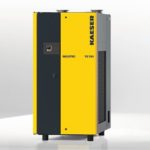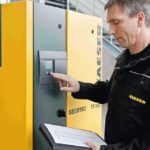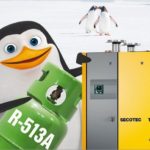Compressed air drying and production go together hand in hand. Virtually every compressed air station uses refrigeration dryers, for the simple reason that virtually every compressed air application requires dry compressed air. The F-Gas Regulation EU 517/2014 aims to minimise emissions of fluorinated greenhouse gases (F-gases) in order to mitigate the effects of global warming. Set in place since 2015, this regulation is now only just beginning to cause ripples in the industrial sector. Operators of compressed air stations count amongst those now feeling the effects, owing to the fact that F-gases are used as a refrigerant in many refrigeration dryers. Any company wishing to service or repair their existing refrigeration dryer, or to purchase a new one, must do so within the confines of the regulation. Refrigerants that have until now been freely available will henceforth gradually be withdrawn from the market – partially by means of outright bans, but also by a deliberate tightening of the supply of refrigerants with high global warming potential (GWP).
The hitherto ubiquitous refrigerant R404A now finds itself firmly in the regulation’s sights. As of this year, the release to market of new refrigeration dryers that use R404A are prohibited. Existing stocks of this refrigerant are only permitted for maintenance purposes in larger systems until 2030, whereupon it will become banned from service altogether. The result is clear to see: R404A will henceforth be difficult to source in large quantities, and will only be available at great cost. And it does not end there …
Shortages ahead
Other commonly used refrigerants with high global warming potential are also being targeted, such as R407C and R410A. Quotas have been assigned to the individual manufacturers and distributors of these refrigerants, limiting the volumes which they are legally allowed to produce and sell. The quotas will gradually be reduced to just 21 % of their initial volumes. The lower the global warming potential of a refrigerant, the higher the volumes that may be produced and sold; as a result, manufacturers are rushing to switch their product ranges over to refrigerants with the lowest possible global warming potential values. Access to refrigerants with high global warming potential will consequently become much more difficult. Many such products currently on the market will no longer be available for maintenance and servicing work, or if they are, only at very high prices.
Operators of compressed air stations would be well advised to check up on which refrigerant their system currently uses and, if necessary, seek advice on possible alternatives. Stockpiling large quantities of refrigerant for later use is not an option for most; operator certification is a prerequisite for purchasing new stocks and the only alternative – sourcing unofficial supplies on the black market – is fraught with danger from a technical point of view, not to mention highly illegal. As a starting point, all operators of refrigeration dryers – particularly older units – should have them serviced by a certified technician as soon as possible, to ensure there are no leaks in the refrigerant circuit that could waste precious supplies. There are also new regulations regarding mandatory leak testing that must be adhered to.
Not a feasible alternative
Unfortunately, in many cases, simply converting an existing dryer to use a new refrigerant is not a feasible alternative. It is not always technically possible to do so and even when it is, it can be prohibitively expensive. In such cases a better option in the long run would be to invest in a new dryer altogether.
The enormous strides recently taken in the development of dryer technology mean that there are several advantages to this option. The latest generation of dryers are designed for the highest levels of efficiency and energy-saving, and frequently take up much less space than their older counterparts. On top of securing their future supplies of refrigerant, operators will also benefit from reduced energy and servicing costs.
Think about the future
Any operator planning to invest in a new refrigeration dryer should first ensure not only that refrigerant supplies for it are currently available, but that they will continue to be available for service purposes over the entire lifecycle of the machine. By far, the safest choice is to go with a refrigeration dryer that already operates using a refrigerant with the lowest possible global warming potential, or at the very least, one that is capable of being converted inexpensively for use with it at a later date.
Some manufacturers continue to use refrigerants that, whilst currently unrestricted, are bound to be either banned completely or gradually withdrawn from the market in the near future. Inevitably, operators using these systems will find themselves in trouble sooner or later.
The most proactive manufacturers of refrigeration dryers are already offering products using a new generation of refrigerants such as R-513A, which has the lowest
GWP value of all refrigerants on the market today, thereby ensuring the most future-proof and climate-friendly solution currently available.
Kaeser Kompressoren SE, Coburg, Germany
 Thanks to a frequency-controlled radial fan, Secotec TG refrigeration dryers can be connected directly to the central exhaust air ducting
Thanks to a frequency-controlled radial fan, Secotec TG refrigeration dryers can be connected directly to the central exhaust air ductingPicture: Kaeser
Refrigeration dryers: TG-series
High-performance TG-series refrigeration dryers from Kaeser not only impress with their latent heat storage system, future-proof use of climate-friendly R-513A refrigerant and relatively small footprint – they now also benefit from a new exhaust air system, which elevates these high performers to an entirely new level of cost efficiency when it comes to compressed air treatment.
Designed for large-scale industrial operations, these compact powerhouses are capable of delivering flow rates of up to 98 m3/min and ensure stable pressure dew points, even under the most challenging conditions – all whilst guaranteeing maximum reliability and minimal lifecycle costs.
When installed in a location that is less than ideal, energy consumption can increase due to a build-up of heat inside the dryer. The frequency-controlled radial fan fitted to TG-series dryers is designed to allow the dryer to be connected directly to a facility’s central exhaust air ducting – making this potential issue a thing of the past. Furthermore, thanks to space-saving component layout, the new units are smaller than their predecessors, meaning operators save on space as well as operating costs.









